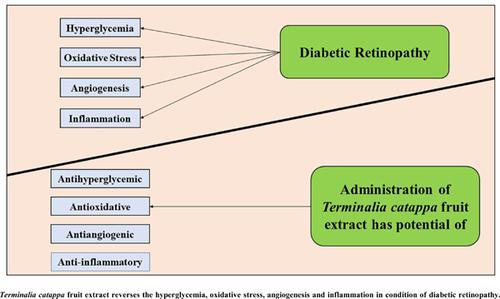Endocrine, Metabolic & Immune Disorders - Drug Targets ( IF 2.0 ) Pub Date : 2021-05-31 , DOI: 10.2174/1871530320666201029142113 Tapan Behl 1 , Thirumurthy Velpandian 2 , Anita Kotwani 3

|
Objective and Background: Diabetic retinopathy is amongst the most common microvascular complications associated with diabetes. Controlling blood glucose level alone cannot manage diabetes associated complications. Thus, mechanisms that additionally prevent diabetes associated complications are the need of the hour, driving the researchers towards herbal therapies. Terminalia catappa is renowned for its anti-inflammatory, antioxidant, anti-hyperglycemic and anti-angiogenic activity. The current study explores the effect of Terminalia catappa fruit extract on streptozotocin-induced diabetic retinopathy in rats.
Methods: Streptozotocin-induced chronic diabetic rat model was utilized in the study. The hydroalcoholic fruit extract of T. catappa in 20mg/kg, 30mg/kg and 40mg/kg dose and standard anti-diabetic drug, glibenclamide (10mg/kg) was given orally. Retinopathy was evaluated by monitoring lenticular, fundus images and measuring arteriole and venule tortuosity index. Oxidative, angiogenic and inflammatory biomarkers were assessed at the 12th week in the retinal homogenate. Histopathological changes in the retina were also examined. Data was analyzed using one-way Repeated Measure ANOVA followed by the Mann-Whitney test.
Results: The hydro-alcoholic fruit extract of T. catappa significantly decreased blood glucose (p<0.001) in a dose-dependent manner in diabetic rats. Cataract lens was observed in all experimental groups and became clear (grade 0) with 40mg/kg and with 40mg/kg along with glibenclamide at the eighth and sixth week, respectively. The hydro-alcoholic fruit extract in all three doses significantly reduced (p<0.01) arteriole and venule tortuosity in diabetic rats. T. catappa in all three doses in diabetic rats showed a modulatory effect in oxidative, angiogenic and inflammatory biomarkers.
Conclusion: T. catappa reverses diabetes-induced retinopathy by anti-hyperglycemic, anti-oxidant, anti-angiogenic and anti-inflammatory actions, and thus has a potential to be used in diabetes-induced retinopathy.
中文翻译:

榄仁树果实提取物逆转链脲佐菌素诱导的大鼠糖尿病视网膜病变
目的和背景:糖尿病视网膜病变是与糖尿病相关的最常见的微血管并发症之一。仅控制血糖水平无法控制糖尿病相关并发症。因此,需要额外预防糖尿病相关并发症的机制,促使研究人员转向草药疗法。Terminalia catappa 以其抗炎、抗氧化、抗高血糖和抗血管生成活性而闻名。目前的研究探讨了榄仁树果实提取物对链脲佐菌素诱导的大鼠糖尿病视网膜病变的影响。
方法:本研究采用链脲佐菌素诱导的慢性糖尿病大鼠模型。以20mg/kg、30mg/kg和40mg/kg剂量和标准抗糖尿病药物格列本脲(10mg/kg)口服给予T. catappa的水醇果实提取物。通过监测晶状体、眼底图像和测量小动脉和小静脉曲折指数来评估视网膜病变。在第 12 周时评估视网膜匀浆中的氧化、血管生成和炎症生物标志物。还检查了视网膜的组织病理学变化。使用单向重复测量方差分析和 Mann-Whitney 检验分析数据。
结果:T. catappa 的水醇果实提取物以剂量依赖性方式显着降低糖尿病大鼠的血糖(p<0.001)。在所有实验组中均观察到白内障晶状体,并在第 8 周和第 6 周分别用 40mg/kg 和 40mg/kg 与格列本脲一起变得清晰(0 级)。所有三种剂量的水醇水果提取物均显着降低(p<0.01)糖尿病大鼠的小动脉和小静脉曲折。T. catappa 在糖尿病大鼠的所有三个剂量中都显示出对氧化、血管生成和炎症生物标志物的调节作用。
结论:T. catappa 通过抗高血糖、抗氧化、抗血管生成和抗炎作用逆转糖尿病引起的视网膜病变,因此具有用于治疗糖尿病引起的视网膜病变的潜力。











































 京公网安备 11010802027423号
京公网安备 11010802027423号